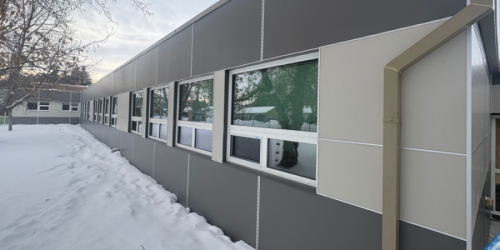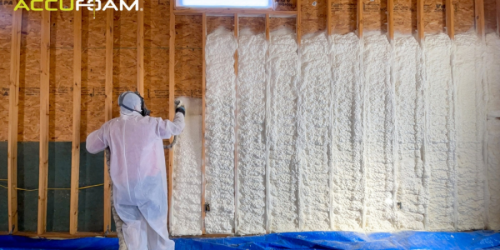Q&A Forums
How thick can you go with CC Post New Topic | Post Reply
| Author | Comments |
|---|---|
|
Posted: Oct 12, 2007 08:40 PM
|
How thick can you go with CC
I have seen that a couple of open cell foams have special ES reports letting them be sprayed 10" thick for residential roofs. Is there a brand of closed cell that meets the tests (astm 84, or other real room tests) requirements for being sprayed thick in a home. I see some brands that state 3 or 4" is max for a icc code comliant install. I have also seen some mention in BOCA code that mentions the use of sprinklers where the max thickness has been exceeded.does anyone know the real rules on this? Rob Carpenter in Colorado |
|
Posted: Oct 12, 2007 09:23 PM
|
for instance, BASF has a comfort foam CC that states 8" in walls and 12" in ceilings under NFPA 286. then further down on the same document it states that typical installations are limited to 4". Does a NFPA 286 rateing mean that its all good for spraying that thick in a resedental applicatiopn? |
|
Gerry Wagoner
Posted: Oct 13, 2007 09:45 PM
|
Sealite can be sprayed at 12". oG |
|
Posted: Oct 13, 2007 11:53 PM
|
Isn't Sealite an OC not a CC? |
|
Posted: Oct 18, 2007 07:02 PM
|
I've been talking with the foam guy at BASF and he says we are all good for spraying up to 12 inches in a roof and that their nfpa286 test is good enough to show that it meets code. Is there ANY other closed cell foam out there that meets code when sprayed over 5" thick? |
|
Huey Reed
Posted: Oct 20, 2007 11:36 PM
|
If 4 inches is being used in commercial refrigeration equipment, walk-in coolers, to 60,000 s.f. freezers, why would you need more than 4" for anything? |
|
Posted: Oct 21, 2007 10:33 PM
|
Because 7 inches of foam performs better than 4" does. I've heard about foam, and the law of diminishing returns but I dont think 4" is the point where additional foam does not matter. A quick WUFI run for a very cold climate shows 4" of CC passing 277btu/sf over a 2year season. 7" of foam loses 166 btu/sf over 2 seasons. |
|
Dave Strnad
Posted: Oct 22, 2007 06:33 AM
|
It all depends of fuel costs and price of spray foam. In the example you described for a 2000 sqft house that is a difference of about 2.6 gals of propane or roughly $5.00 difference for 2000 sqft or $0.00132 per sqft. |
|
Posted: Oct 22, 2007 09:12 AM
|
Dave, I see what you mean about the diminishing returns on the dollar. The main reason for looking into a thicker install is our local building code. R-41 for now with plans to bump up to R-49 in roof apps. |
|
Richard Russell
Posted: Oct 22, 2007 11:16 AM
|
Rob, even guessing at the assumptions you made in your calcs, I don't come anywhere close to your numbers (277 and 166 BTU/ft2/2 yrs). My own quick calc: For 2000 ft2 area, R @6/inch, and 8000 HDD, the 4" calc would be: Q=A/R = 2000/24 = 83.333 BTU/hr/F, That times 24 hr/day times 8000 HDD gives 16,000,000 BTU/yr. For 7", R=6x7= 42 (ignoring thermal bridging, not insignificant), the same annual calc gives 9,143,000 (rounding), and the saving is 6,857,000 BTU/yr. Propane net heating value is 19,767 BTU/lb, or 83,476 BTU/gal (API Technical Data Book). Dividing the savings by that heating value and assuming a 90% efficiency gives 91.3 gallons propane saved per year. At $2.40/gal (sure to go higher), that comes to $219/yr. If the CC costs $1.00/bd.ft, that extra 3" costs $6000. That $219 still takes 27 years to pay out. Then there is the matter of the ignored thermal bridging of the framing, making the payout longer. Assuming open cell foam gives R 3.8/inch, but costs 1/3 per installed board foot, the cost of gaining that extra R18 of insulation would be about half, placing the payout into the realm of what is reasonable (to some) for long-term home ownership. The above seems to suggest two things. One, that achieving very high R values is done more cost-effectively with open cell foam than CC. Second, what has been suggested elsewhere, that going to high R value walls can be achieved at lower cost by using either SIP walls or double framing, so as to provide ample space for a less expensive insulation with reasonable R per inch (cellulose). Some have gone the route of a foam layer for air sealing plus a hefty layer of cellulose. I'd really like to see further discussion of high R assemblies and the role of foam in that. I also want to know if my calcs are in error, of course. |
|
Posted: Oct 22, 2007 03:29 PM
|
thanks for showing me the correct math for the btu numbers, When I find out what the numbers from the wufi software really mean, I'll share it with you. The lower numbers were for the line Heat Flux, and shown in btu's /sf WUFI has a free version that is available online, I'm still learning the basics myself. I've been using it to predict moisture movement in walls and roofs, but it also has thermal results as well. You should check it out. http://www.ornl.gov/sci/btc/apps/moisture/ I think I figured out what the WUFI heat flux number represents. I believe it is the average btu/hr/sf over the 2 year period. If anyone here knows WUFI software can you confirm this?? 150 btu X 24 X 365 = 1,314,000 btu's per sf per year. |





























